The guys were collectively skeptical
about this non-Avid approach, yet were very intrigued. At that
time, DFT had successfully applied its workflow with many students
and ultra low budget filmmakers. Many conversations about the
pros and cons of this approach ensued. In the end, the guys,
with Shawn at the helm, courageously decided to go with Final
Cut Pro.
Fast-forwarding a year, "The Month
of August" has been delivered to Angelic Entertainment and is making the rounds
at festivals and prospective distributors. It is the first feature
length film to follow DFT's postproduction workflow. In short,
everything from the final negative cut to final sound mix worked
perfectly and frame accurately. At the bottom of the page is
a brief bio on the film.
Half way through editing, DFT chatted
with Shawn and Rex about how things were going. We visited them
at their edit suite, which happened to be in Shawn's converted'
bedroom at his home in the Silver Lake Hills, California. Below
are excerpts from our conversations.
Interview with Shawn Paper and Rex
Piano
DFT:
Working with just one editor who does everything, what is your
general impression - right off the bat - of not having an assistant
editor? We (DFT) have long maintained that a good assistant editor
is critical.
Rex:
When I did TV shows, I didn't really interact with an assistant,
so I've always just worked with one editor. I don't know what
an assistant does, really (laughing). So that is about it.
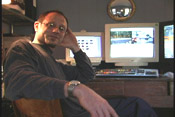 Shawn: What I've come to discover is that as the [NLE]
systems get easier, and if you have a technical background or
are an editor who has moved up the chain from being an assistant;
even though it is a lot more work you can do editing and assisting
and finish your show all by yourself. I haven't slept in about
a week but I think my director is going to be happy.
Shawn: What I've come to discover is that as the [NLE]
systems get easier, and if you have a technical background or
are an editor who has moved up the chain from being an assistant;
even though it is a lot more work you can do editing and assisting
and finish your show all by yourself. I haven't slept in about
a week but I think my director is going to be happy.
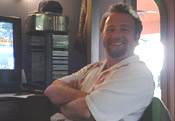 Rex: Yeah, I am very happy with what we are getting
here. By virtue of the fact that we're working out of Shawn's
house, its just a nice comfortable place to work and we can cut
as long as we want, we can go out and I don't feel the pressures
when I am in a facility - that I have to be out by this time
or that time and the food that you have to eat and all that stuff.
So, I just like that we go out on the deck and smoke, drink a
little bit, and the cut looks so much better, it's amazing (laughing).
Rex: Yeah, I am very happy with what we are getting
here. By virtue of the fact that we're working out of Shawn's
house, its just a nice comfortable place to work and we can cut
as long as we want, we can go out and I don't feel the pressures
when I am in a facility - that I have to be out by this time
or that time and the food that you have to eat and all that stuff.
So, I just like that we go out on the deck and smoke, drink a
little bit, and the cut looks so much better, it's amazing (laughing).
DFT:
That is too cool, to be able to have a drink and just kind of
have a relaxed atmosphere.
Shawn:
I try to provide from my home the benefits of a facility with
the benefits of a bed, if you decided to stay all night cutting,
and I don't want you to drive the next morning. We don't have
a shutoff time, which is both good and bad. Once inspiration
hits us, we do not have to worry about the keys to the cutting
room.
Rex:
The only thing that Shawn hasn't offered me is his girlfriend
and I don't think she'd be happy anyway.
DFT:
What kind of system do you have there?
Shawn:
I built my own system from the ground up with some help from
Dan Fort. It's a G4 450Mhz with 320MB of RAM. I got 140GB of
SCSI hard drive space. I have got another 30GB of ATA and another
30GB FireWire drive that has worked fine with the Final Cut Pro
1.2.6 upgrade (knock on wood).
Shawn:
We haven't had any problems with the media and I am storing about
20 hours of DV material that looks better than the Avids', going
back AVR12. I think the director is very happy with what the
image looks like on the screen and I can make minute changes
and be able to see the image clearly, precisely. I hear with
Quick Time 5, the next version of Final Cut Pro is going to look
even better.
DFT:
Do you want to say something about your film, so that people
will know what you guys are doing. Like, what is it?
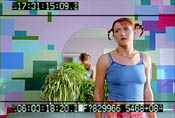 Rex: We are cutting this picture "The Month
of August". A fun little romantic comedy - I do not want
to sound like a pretentious a--hole, but I will - hopefully it
kind of has a European / late 60's feel to it. We are doing some
stuff with transitions that Final Cut Pro has enabled us to do;
that Avid we were going to rent wouldn't. That is building multi-layered
video images with complex matte moves and we can do them exactly
as we want to see them, versus with an Avid. I'm used to cutting
on old film where you have to deal with chalk lines. With this
Final Cut Pro, we can do it frame accurately, change the sizes
of the images how we want, you'll see one right now, and it's
just really cool I think.
Rex: We are cutting this picture "The Month
of August". A fun little romantic comedy - I do not want
to sound like a pretentious a--hole, but I will - hopefully it
kind of has a European / late 60's feel to it. We are doing some
stuff with transitions that Final Cut Pro has enabled us to do;
that Avid we were going to rent wouldn't. That is building multi-layered
video images with complex matte moves and we can do them exactly
as we want to see them, versus with an Avid. I'm used to cutting
on old film where you have to deal with chalk lines. With this
Final Cut Pro, we can do it frame accurately, change the sizes
of the images how we want, you'll see one right now, and it's
just really cool I think.
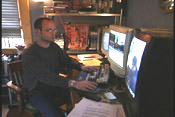 Shawn: Final Cut Pro can give us - with its After
Effects style interface - a lot more agility to perform complex
compositing that you can't do with other systems. With QuickTime
and After Effects you can generate a lot more key frame specific
motions that we cannot do on other systems. So, coming from an
Avid background and having known these other programs, I've come
in with a few hours of training and have been able to cut a scene.
And in about three or four days I was proficient in cutting this
film as quickly and with the agility of keyboard and mouse, left
hand/right hand movement that I had been used to with years of
Avid experience.
Shawn: Final Cut Pro can give us - with its After
Effects style interface - a lot more agility to perform complex
compositing that you can't do with other systems. With QuickTime
and After Effects you can generate a lot more key frame specific
motions that we cannot do on other systems. So, coming from an
Avid background and having known these other programs, I've come
in with a few hours of training and have been able to cut a scene.
And in about three or four days I was proficient in cutting this
film as quickly and with the agility of keyboard and mouse, left
hand/right hand movement that I had been used to with years of
Avid experience.
DFT:
I like that shot right there, that's an awesome shot. [indicates
shot of two girls in bikinis]
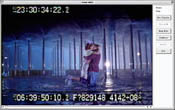 Shawn: It's a lot easier looking at this [full DV
resolution] than a pixilated image for soooo many hours where
I would loose my mind. I'm so happy with this DV codec, and being
able to see something as pristine as this, and this is offline!
It looks like AVR 75 or something that is a finish image on Avid.
So, Final Cut Pro has allowed me to work more and with less eyestrain.
Shawn: It's a lot easier looking at this [full DV
resolution] than a pixilated image for soooo many hours where
I would loose my mind. I'm so happy with this DV codec, and being
able to see something as pristine as this, and this is offline!
It looks like AVR 75 or something that is a finish image on Avid.
So, Final Cut Pro has allowed me to work more and with less eyestrain.
DFT:
What are some of the downsides of Final Cut Pro?
Shawn: The trim command is not as precise
as the Avid is. I am unable to do asynchronous cut points in
the video / audio and slide it globally in the trim mode as I
can in an Avid.
DFT:
I love how editors talk.
Rex:
Yeah, exactly, I didn't understand a word Shawn said.
Shawn:
You know, like in trim mode I can slip shots, and easily find
the different cut points and just say, I want to trim this side
ten frames on track 2 and on track 1 I'd like to add four frames.
I can't have two different tracks slide in relationship to itself
and stay in sync, preview it and audition the cut and go back
into cutting mode. It takes another two steps to do that.
Shawn:
QuickTime doesn't have the ability to process two images at once
without having to render it as some kind of file. It has a really
sophisticated rendering engine that you can manage well. You
can go in and say, alright I see all these render files, I'll
just use my cache manager and just delete all of the files of
dissolves in a sequence that are taking up space that I don't
need anymore.
Shawn:
On Avid, you have to go through media manager, open up the media
tool, locate it and associate it to a hard disk somewhere on
your system, hidden underneath your editing application, and
delete the image and hope you didn't delete the wrong thing.
Shawn: I'm waiting for multi-processing power with Apple's OS X, or there are other cards like the Aurora Igniter or Digital Voodoo or Pinnacle Cine. They say that these developments will allow a lot more real-time rendering. When that happens it will be great because that will save us time. When you say all right, Shawn let's see what a two frame fade looks like as opposed to a three foot fade, I would simply slap it on there, rather than having to wait for render.
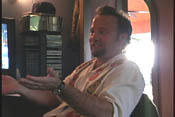 Rex: When we were talking about deciding to edit
on Final Cut Pro or the Avid - a negotiation we were having -
basically to get the effects that I wanted, we would have to
get a top of the line Avid, which was going to be twice the weekly
rental of this Final Cut Pro System and wouldn't look as good.
I don't know anything about computers or anything, I just know
what I see and say cut it here and do this, do that; and this
looks a hell of a lot better than the stuff I cut on Avid. Like
I said earlier, we can do all of these cool effects and see what
they are going to look like finished, for a lot less money.
Rex: When we were talking about deciding to edit
on Final Cut Pro or the Avid - a negotiation we were having -
basically to get the effects that I wanted, we would have to
get a top of the line Avid, which was going to be twice the weekly
rental of this Final Cut Pro System and wouldn't look as good.
I don't know anything about computers or anything, I just know
what I see and say cut it here and do this, do that; and this
looks a hell of a lot better than the stuff I cut on Avid. Like
I said earlier, we can do all of these cool effects and see what
they are going to look like finished, for a lot less money.
Story by Ramy
Katrib
Workflow by DigitalFilm
Tree
©2001 DigitalFilm Tree,
LLC
_____________________________________________________________
"The Month of August"
Plot Summary:
A single-minded man focused on finding the girl of his dreams,
the perfect vision he's created in his mind's eye. True love
is right around the corner as long as he doesn't lose sight of
what he's looking for. Nick is about to discover, true love can
be found in the strangest of places... and in the strangest of
girls.
About
Digital
Film Tree
For the past two years now, DigitalFilm Tree (DFT) has been mixing
existing film and video systems with merging technologies like
Final Cut Pro, FilmLogic, DVCAM and related technologies. It
all started in 'our garage' on 3/11/00 when we successfully transferred
film dailies directly to DVCAM, edited on Final Cut / FilmLogic,
generated an accurate negative cut list, and then cut the negative
flawlessly. Since then, we have engaged hundreds of editors,
filmmakers, and institutions with our message and have gone on
to serve over one hundred productions.
We have also attempted to elevate the curious debate between
film vs. HD technology pundits and other warring camps. We say
film good, HD good, DV good, all well. The idea is that filmmakers
can work with the medium that suite them best. We can only hope
that filmmakers are as passionate about the quality of their
story as those who hark the demise of film.
This article
first appeared on digitalfilmtree.com and is reprinted here with
permission